#EMOttawaPTMBlog
The EMOttawa Blog is excited to announce a new series joining our Blog Family :
The Prehospital and Transport Medicine [PTM] Blog Series.
In conjunction with the Prehospital and Transport Medicine Fellowship program at Emergency Medicine Ottawa, as well as the Regional Paramedic Program for Eastern Ontario, this corner will aim to bring you up to date information on core topics in PTM, as well as reviews of emerging literature (Click HERE to read our last update on the topic).
So … what is PTM?
In the purest of its definition, Prehospital and Transport Medicine pertains to emergency medical services delivered outside the boundaries of the hospital1. Traditionally many would think of 9-1-1. AKA the emergency medical services or response teams that respond to crisis’ through a specified emergency line specific to a set country – 911 in North America, and 999 in the UK. However, PTM is more than just the emergency medical services delivered through the standard paramedic programs seen across these countries. Rather it is a rich area of Emergency Medicine with several sub-specialized disciplines, which are briefly summarized below.
(1) Emergency Medical Services (EMS)/ Emergency Paramedicine
This sector of PTM is home to the traditional first responder paramedicine teams. It focuses on the prehospital care that is delivered from a patient’s home or scene of an accident, to the physical transfer of a patient into the care of the nearest emergency department.
Within Ontario, our regions operate using a Base Hospital system1. Using this system, one hospital/organization and its associated medical director, provide the medical directives, training and leadership support in the coordination and delivery of multidisciplinary EMS services within a region.

Here in Ottawa, we are lucky to work alongside the Regional Paramedic Program of Eastern Ontario6. From responding to accidents along the Queensway, to helping a mother deliver her unborn child, emergency paramedicine is present for all acute and sometimes non-acute medical needs throughout the region.
(2) Community Paramadecine
This is a newly evolving area of PTM. It is in of itself a new healthcare model2, wherein paramedics partake in primary care and public health capacities, instead of the traditional transport or emergency response capacities they have previously fulfilled.
Originating in the early 90s3 in Canada, with a program existing in Toronto since 1999, the focus of Community Paramedicine is vast. From wellness checks on elderly individuals to avoid admissions to hospitals, delivery of home palliative care services, to helping marginalized populations navigate the healthcare system, as well as mass delivery of public health messaging, these programs are vast4. In Ottawa, and throughout Canada, paramedicine programs were particularly highlighted during the COVID-19 pandemic. They were specifically used to assist with the delivery of COVID-19 vaccinations to elderly homebound citizens, as well as numerous retirement and long-term care residences5.
(3) Transport Medicine
Think ambulances, helicopters and planes …. well, there’s a little bit more to it, but these different methods of transportation play an integral role in the world of transport medicine in North America. This particular discipline of PTM is not mutually exclusive to Emergency Paramedicine. However, in Ontario, the concept of Transport Medicine is often used to refer to Air Transportation7. With the vast Canadian geography, emergency transport medicine specialists focus on developing alternative transportation systems and avenues, separate from the use of land ambulances. Often trained in critical care, physicians working in transport medicine are responsible for the safe transfer of patients from various areas of the province to which they are assigned. They become experts on the optimization of patients’ physiology to facilitate safe transportation in the air environment.
(4) Wilderness Medicine
Backcountry camping, downhill skiing, fishing and camping – Wilderness Medicine focuses on emergency medical response in environments with remote access, and where mother nature governs all8. This discipline focuses on retrieval efforts in remote locations, education of the general public on emergency techniques they can perform, and on advanced emergency medicine skills for medical professionals within a resource-limited setting.
(5) Disaster Medicine
Large scale events such as concerts, a global pandemic, a bio-terrorist attack, and many more scenarios make up the backdrop for disaster medicine. A marriage between emergency medicine and disaster preparedness, this PTM discipline focuses on mastering and understanding all four aspects of the disaster cycle for various scenarios.
Here in Ottawa, we had our very own disaster event in 2019, with the Westboro bus crash, where we learned several lessons in Disaster Medicine/Code Orange. To read more click HERE.
Want to learn more about the above fields? Make sure to stay tuned for this new #EMOttawaPTMBlog series, with content arriving monthly!
References
- https://ontariobasehospitalgroup.ca/index.php/sample-page/
- https://www.ruralhealthinfo.org/topics/community-paramedicine
- https://www.ncbi.nlm.nih.gov/books/NBK549083/#:~:text=In%20the%20United%20States%2C%20the,improving%20rural%20community%20health%20care.
- https://www.ottawapublichealth.ca/Modules/News/blogcomments.aspx?BlogId=f9643bbf-ea99-4d47-a525-751b694f11b5
- https://www.cp24.com/news/paramedics-bring-covid-19-vaccines-to-homebound-seniors-across-ontario-1.5369265?cache=a+href%2F7.573166%3FcontactForm%3Dtrue
- https://www.rppeo.ca/
- https://www.health.gov.on.ca/en/pro/programs/emergency_health/edu/docs/patient_care_trans_standards_v2.3.pdf
- https://wms.org/about/

